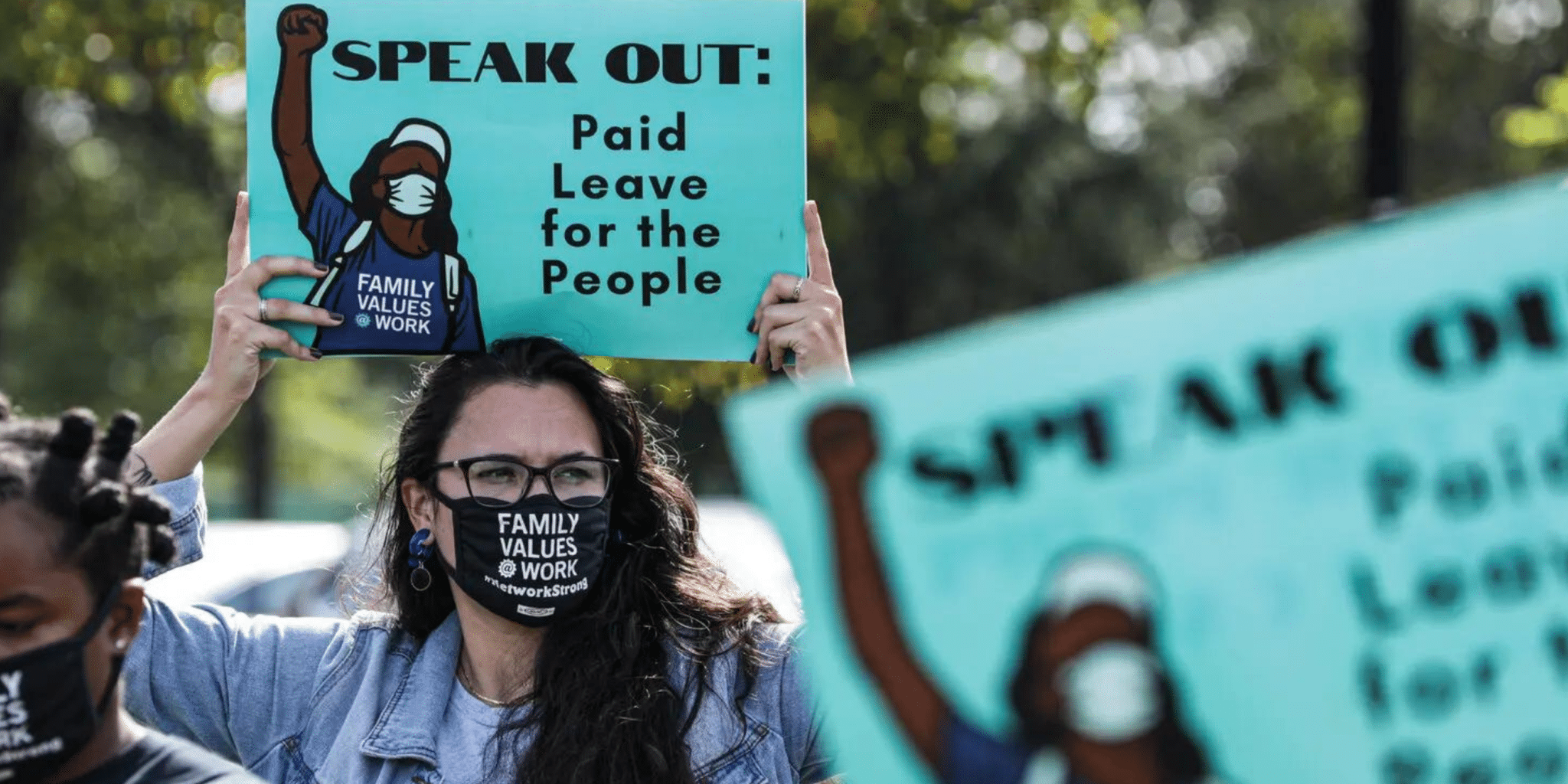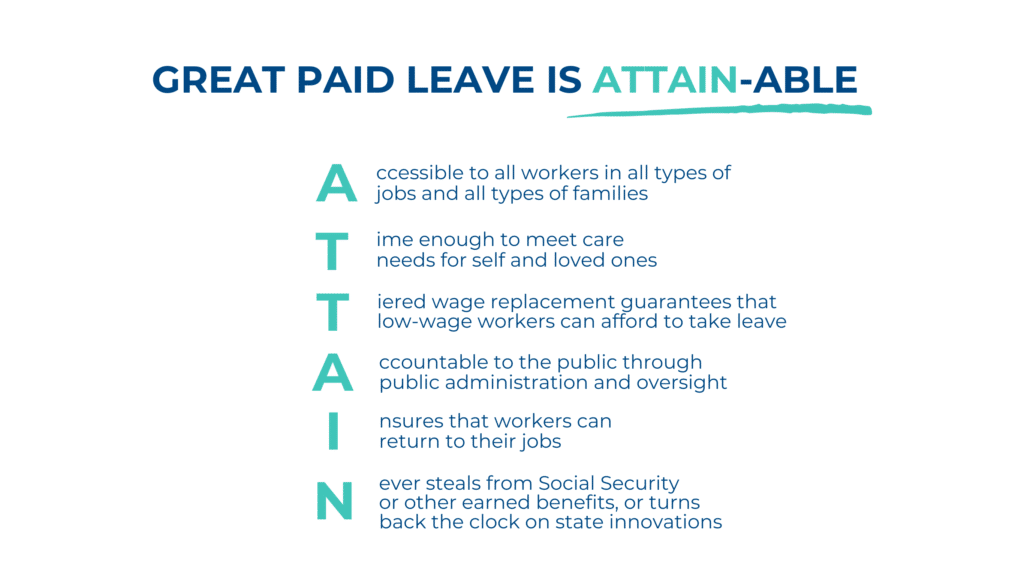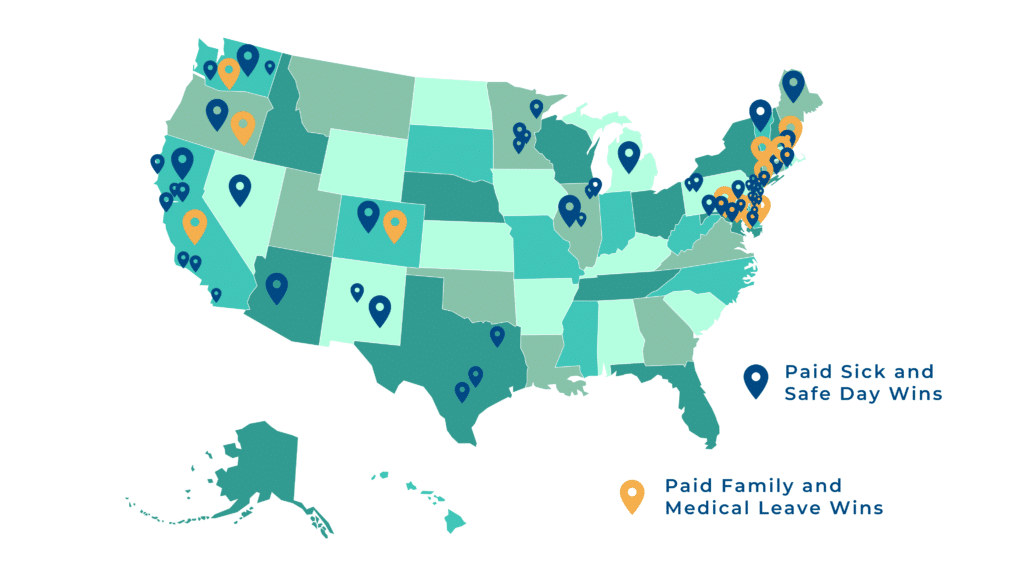What is Paid Leave? And How Do We Make it Work for Everyone?

Nearly everyone needs time to recover from a serious illness or care for a sick loved one, themselves, or welcome a new child. The majority of working people in the United States cannot take the time they need without risking their jobs or economic security. At Family Values @ work, we know that there is a solution to this problem: paid leave.
When we talk about paid leave, we are actually often talking about several different policies at the same time.
Some examples of why someone might need paid time to care include:
- Time to care for ourselves, be it a chronic condition or a brief illness
- Time to care for a new child
- Time to care for our family, be they blood relatives or chosen family
- Time to care to address the impact of domestic violence, stalking, and sexual assault
- Time to care for our mental health
At Family Values @ Work, we focus on three different policy solutions that can help establish paid time to care:
- Paid Family and Medical Leave (PFML)
- Paid Sick and Safe Days (PSSD)
- Paid Time Off (PTO)
For the past 20 years, FV@W and our movement network have worked on these issues, and not only are we working on them, we’re winning and changing millions of lives.
As of August 2023, we’ve won paid family and medical leave in 14 locations and paid sick and safe days + paid time off policies in 62 locations, impacting more than 55 million workers and their families.
Let’s get into it: What is paid leave? What is the difference between paid family and medical leave and paid sick and safe days? Why does it matter how a policy is structured?

At Family Value @ Work we know that not only is paid leave possible, good, equity-driven paid leave is ATTAIN-able. What that means is that all policies including – paid family and medical leave, paid sick and safe day policies, and paid time off are:
A: Accessible to all types of workers, in all types of jobs
T: Time enough to meet care needs for ourselves and loved ones
T: Tiered wage-replacement that guarantees low-income workers can afford to take leave
I: Insures that workers can return to their jobs
N: Never steals from social security or other earned benefits, or turns the clock back on state innovations
GETTING INTO THE WEEDS OF PAID FAMILY & MEDICAL LEAVE
Right now the only national standard in the United States related to this is the Family and Medical Leave Act (FMLA), which became law in 1993. FMLA allows for people who work for larger companies to have unpaid, job-protected, longer periods of time off to care for themselves, a new child (through birth, adoption or foster care) or a seriously ill child, spouse or parent. While FMLA has helped more than 460 million people since its inception, many people struggle to make ends meet when they are in a family crisis and have to take time without pay.she FMLA leaves out 40 percent of the workforce and excludes even more by its narrow definition of family.

Real, impactful paid family and medical leave would mean an ATTAIN-able policy that is:
Accessible to all workers in all types of jobs and all types of families
- Be equitable in its impact, especially considering the needs of low-wage, BIPOC, female, LGBTQ, part-time, and nontraditional workers;
- Use the gold standard inclusive family definition of blood or affinity
Time enough to meet care needs for self and loved ones
- Maintain a minimum of 12 permanent weeks of leave.
Tiered wage replacement ensures low-wage workers can afford to take leave
- Make benefit amounts progressive and affordable. Benefits should start at no less than 85% replacement of usual wages for the lowest earners. This ensures that all workers can afford to use the benefit
Accountable to the public through public administration and oversight
- Public agencies by nature are accountable to and serve the public. They have built-in systems to course correct and improve services. Public agencies answer to elected officials, are experienced with stakeholder advisory committees, and have other means of direct public input.
Insures that workers can return to their jobs
- Without ensuring that workers jobs are secure, it removes the ability to take paid leave with confidence
Never steals from Social Security or other earned benefits, or turns back the clock on state innovations
- States need to be given the opportunity to innovate and demonstrate even greater advancements to move paid leave forward continually
- Any proposal that is structured as a tax credit or by borrowing against social security is not true paid leave – we believe a social insurance model is the only true way to ensure an equitable program
- You may hear an argument against this including logic that social security is already broken – however the states have proven time and again that this is the most effective structure.
- The FAMILY Act (our primary federal legislation has historically included social insurance funding would be funded by small employee and employer payroll contributions of
- two-tenths of 1 percent each (two cents per $10 in wages), or less than $2.00 per week for a typical worker
- More background on why social insurance model is covered under the New America Brief in the section “Paid Leave is Funded Sustainably and Affordably”
GETTING INTO THE WEEDS OF PAID SICK & SAFE DAYS and PAID TIME OFF
Keeping in line with our ATTAIN-able framework paid sick and safe days and paid time off policies have a chance to provide workers with shorter term paid days to take care of:
- Time to recover from a physical/mental illness or injury
- Seek medical treatment or preventative care
- Care for a sick family member
- Time to address needs from domestic violence, or stalking
Paid sick and safe days and Paid Time off policies must also ensure that the time is paid at full wages, uses an inclusive family definition, and is job protected. These short term policies are essential for our public health.
- We are all only as healthy as our communities – in the wake of COVID-19, the need for a paid sick and safe days policy has never been clearer. The sick leave provision in FFCRA significantly flattened the curve of COVID-19 cases in the early months of the pandemic by averting approximately 400 cases per day in states that previously did not guarantee sick leave.
- Before the pandemic, 23 states had preempted localities from enacting their own paid sick time laws. Since the COVID-19 outbreak, 32 states or localities have acted to protect workers by passing new paid sick days laws or expanding existing benefits or eligibility
- Low-wage workers, including food service, personal health care and childcare workers, are the least likely to have paid sick days and the most helped by paid sick days laws. In 2022, only about half—53 percent—of leisure and hospitality workers had paid sick time. Similarly, only about half of food service and accommodation workers (52 percent) have paid sick time
- Paid sick days reduce the risk of on-the-job injury. In fact, according to a study by the National Institute for Occupational Health and Safety, workers who are able to earn paid sick days are 28% less likely to get injured on the job.
- Workers with paid sick days are more likely to visit the doctor once a year and get key cancer screenings such as a mammogram or colonoscopy. Workers without paid sick days are more likely to delay medical care when they are ill.
Paid leave has remarkable benefits for workers, employers, and the economy. Women are more likely to return to work, parents use less public assistance if they receive paid leave, and families are less likely to file for bankruptcy. Affordable time to care also helps the health of the person who takes the leave and their loved ones.
Join us in the fight to pass ATTAIN-able paid leave in your state, and at the federal level!